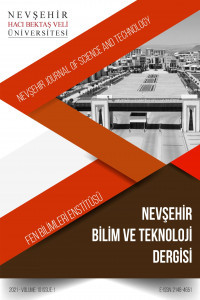Fren Sürtünme Malzemelerinde Aşındırıcıların (Alümina, Silika, Zirkon) Tribolojik Özellikleri
Aşındırıcılar, Fren balatası, Aşınma, Sürtünme, Triboloji
Tribological Properties of Abrasives (Alumina, Silica, Zircon) for Brake Friction Materials
Abrasives, Brake lining, Wear, Friction, Tribology,
___
- Bijwe, J., Aranganathan, N., Sharma, S., Dureja, N., Kumar, R., “Nano-abrasives in friction materials-influence on tribological properties” Wear, 296(1), 693-701, 2012.
- Kim, S. S., Hwang, H. J., Shin, M. W., Jang, H., “Friction and vibration of automotive brake pads containing different abrasive particles” Wear, 271(7), 1194-1202, 2011.
- Shin, M. W., Kim, Y. H., Jang, H., “Effect of the abrasive size on the friction effectiveness and instability of brake friction materials: a case study with Zircon” Tribology Letters, 55(3), 371-379, 2014.
- Ma, Y., Martynková, G. S., Valášková, M., Matějka, V., Lu, Y., “Effects of ZrSiO 4 in non-metallic brake friction materials on friction performance” Tribology International, 41(3), 166-174, 2008.
- Boz, M., Kurt, A., “The effect of Al2O3 on the friction performance of automotive brake friction materials” Tribology International, 40(7), 1161-1169, 2007.
- Ertan, R., “Fren Balata Malzemelerinin Optimizasyonu ve Üretim Parametrelerinin Analizi” Uludağ Üniversitesi, Fen Bilimleri Enstitüsü Doktora Tezi, Bursa, 2008.
- TS 555 Karayolu Taşıtları-Fren Sistemleri-Balatalar-Sürtünmeli Frenler İçin, 1992.
- TS 9076 Karayolu Taşıtları-Fren Sistemleri-Fren Balataları-Malzeme Sürtünme Özelliklerinin Küçük Deney Parçaları ile Değerlendirilmesi, 1991.
- Sugözü, I., “Investigation of using rice husk dust and ulexite in automotive brake pads” Materials Testing, 57(10); 877-882, 2015.
- Hong, U. S., Jung, S. L., Cho, K. H., Cho, M. H., Kim, S. J., Jang, H., “Wear mechanism of multiphase friction materials with different phenolic resin matrices” Wear 266(7); 739-744, 2009.
- Sugözü, B., Nano Silika, Nano Alümina ve Nano Zirkon Aşındırıcı Parçacık Katkısının Fren Balata Özelliklerine Etkisi, Selçuk Üniversitesi, Fen Bilimleri Enstitüsü Doktora Tezi, Konya, 2016.
- Persson, B. N. J., “Theory of friction: The role of elasticity in boundary lubrication”, Physical Review B 50(7); 4771, 1994.
- Tabor, D., “Friction as a dissipated process. Friction of organic polymers in fundamentals of friction” Macroscopic and Microscopic Processes 220(3); 1996.
- Moore, D. F., “Princippless and Application Tribology”, In, Eds, Oxford: Pergamon Press, p. 109-156, 1975.
- Anderson, A. E., “ASM handbook, Friction, lubrication, and wear technology” 18; 569-577, 1992.
- Stachowiak, G.W., Batchelor, A.W., “Engineering Tribology”, Heineman, Boston, MA, pp. 36-44, 2001.
- Sasaki, Y., “Proceedings of the Fifth Akzo Symposium on Development of Non-asbestos friction materials”, 1986.
- Bijwe, J., “Composites as friction materials: Recent developments in non-asbestos fiber reinforced friction materials - A review” Polymer Composites, 18 (3), 378-396, 1997.
- ISSN: 2148-466X
- Yayın Aralığı: Yılda 2 Sayı
- Başlangıç: 2012
- Yayıncı: Nevşehir Hacı Bektaş Veli Üniversitesi
Fren Sürtünme Malzemelerinde Aşındırıcıların (Alümina, Silika, Zirkon) Tribolojik Özellikleri
Effect of Different Metal Oxides On Vickers Hardness of the Frit Based Crystalline Glazes
Annelerin Çocuk Besleme Uygulamaları ve Çocukların Yemek Yeme Davranışları
Serap BALABAN, Yahya ÖZDOĞAN, Aslı UÇAR
Biyomedikal Uygulamalar İçin Titanyum Esaslı Gözenekli TiNb Alaşımının Üretimi
Mehmet KAYA, Abdurrahman YOLUN, Ömer ÇAKMAK, Fahrettin YAKUPHANOĞLU, Ebru ELİBOL, Mustafa KÖM, Mehmet GÜVENÇ
Kapadokya Bölgesi Nevşehir Yöresi Kültürel Varlıklarının Bozulmalarına Neden Olan Etmenler
Baryum Karbonat İlavesinin Porselen Seramik Karoların Özelliklerine Etkisi
Hülya KAFTELEN ODABAŞI, Ümit Engin ANIL, Akın ODABAŞI, Battal Kadir KOCABIYIK
Günlenmeye Bağlı Oluşan Şekiller ve Yerleşme Üzerine Etkileri, Gümüşhane Örneği
Ali İMAMOĞLU, Selim ERASLAN, Halil ÇOT
3 Fazlı Evirici Devresi için SDGM, SHEDGM, HIDGM ve UVDGM Tekniklerinin Karşılaştırılması
